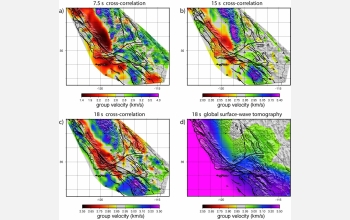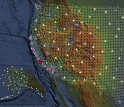News Release 05-035
New Technique Uses Seismic 'Garbage' to View Earth's Interior
Frees seismologists from 'tyranny' of waiting for earthquakes
March 10, 2005
This material is available primarily for archival purposes. Telephone numbers or other contact information may be out of date; please see current contact information at media contacts.
Seismologists have long relied on earthquakes or expensive tools like explosives to help create images of Earth’s interior, but a new method created by University of Colorado at Boulder (CU-Boulder) researchers will produce quicker, cheaper and clearer images.
Rather than waiting for earthquakes, the researchers have recovered surface-wave information from normal seismic noise that is constantly produced by fluctuations in the Earth’s atmosphere and oceans. Measuring surface waves is important because the information helps scientists get a clearer picture of the Earth’s interior, according to Michael Ritzwoller, director of CU-Boulder’s Center for Imaging the Earth’s Interior.
The method is described in the March 11 issue of the journal Science.
“This new technique will give us a better fundamental understanding of the planet by providing much better resolution of Earth’s interior,” Ritzwoller said. “It also will diminish what is known in seismology as the ‘tyranny of earthquakes,’ which means having to wait for an earthquake to happen to do our jobs."
The new method promises significant improvements in the resolution and accuracy of crust and upper mantle images down to 60 miles or more within the Earth, particularly when used with seismic projects like USArray, according to Nikolai Shapiro, a research associate in the Center for Imaging the Earth’s Interior and the study’s chief author.
Coupled with existing and emerging technology, such as USArray, the new measuring technique will lead to a better fundamental understanding of the structure of the planet and may help save lives in the process, Ritzwoller said. A component of the National Science Foundation's (NSF) EarthScope program, USArray includes hundreds of portable seismometers that in coming years will be moved over the entire country, producing images of the Earth’s interior to aid in earthquake risk assessment.
"The authors' application of what used to be 'seismic noise' to the detailed mapping of the crust and upper mantle will have significant impact on earth science and on seismic hazard mitigation," says James Whitcomb, head of NSF's deep earth processes section, which funded the research. "This innovative research foretells what's to come from EarthScope."
Researchers have for years been constructing tomographic images of Earth’s crust and upper mantle from waves generated by earthquakes. That method, known as seismic tomography, reconstructs Earth’s inner structure on a computer screen, slice by slice. The new technique is similar, but is based on organizing ambient seismic noise, which is typically discarded as seismic "garbage."
Seismic tomography is like doing a medical CT scan of the Earth, Ritzwoller said. But when people have a CT scan, doctors are in control and can make images at will. Seismologists can’t control when an earthquake happens, so they can either wait for another one or set off explosives to create their own image-generating waves.
“To move beyond these limitations requires observational methods based on seismic sources other than earthquakes, which is what our method offers,” said Shapiro.
-NSF-
-
EarthScope will install thousands of stations across the country.
Credit and Larger Version
Media Contacts
Cheryl L. Dybas, NSF, (703) 292-7734, email: cdybas@nsf.gov
Jim Scott, University of Colorado at Boulder, (303) 492-3114, email: jim.scott@colorado.edu
The U.S. National Science Foundation propels the nation forward by advancing fundamental research in all fields of science and engineering. NSF supports research and people by providing facilities, instruments and funding to support their ingenuity and sustain the U.S. as a global leader in research and innovation. With a fiscal year 2023 budget of $9.5 billion, NSF funds reach all 50 states through grants to nearly 2,000 colleges, universities and institutions. Each year, NSF receives more than 40,000 competitive proposals and makes about 11,000 new awards. Those awards include support for cooperative research with industry, Arctic and Antarctic research and operations, and U.S. participation in international scientific efforts.
Connect with us online
NSF website: nsf.gov
NSF News: nsf.gov/news
For News Media: nsf.gov/news/newsroom
Statistics: nsf.gov/statistics/
Awards database: nsf.gov/awardsearch/
Follow us on social
Twitter: twitter.com/NSF
Facebook: facebook.com/US.NSF
Instagram: instagram.com/nsfgov




